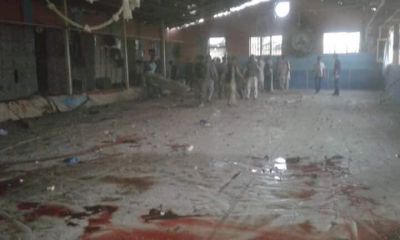Frud Bezhan
Radio Free Europe/Radio Liberty
September 12, 2018
Sayed Ali Rezwan was lifting dumbbells when an explosion ripped through Kabul’s Maiwand sports club, where scores of young wrestlers were in the middle of a training session.
The blast threw 23-year-old Rezwan against a wall. Wounded and covered in dust, he stumbled through the debris to help pull the bodies of the dead and wounded out of the burning gym. The floor was splattered with blood, and the wrestling ring was strewn with body parts.
“Pieces of shrapnel struck me in the chest,” Rezwan, a university student in Kabul, tells RFE/RL. “I didn’t notice I had been wounded. I was helping people inside the club. There were arms and legs on the floor. Many of the wrestlers inside were lying on the ground.”
Rezwan eventually collapsed from his injuries and was rushed to the hospital.
He says there were around 100 people inside the gym when the suicide bomber struck on the evening of September 5, including wrestlers aspiring to make the Afghan Olympic team.
Less than an hour after the blast at Maiwand, a car laden with explosives exploded outside another, nearby sports club in Dasht-e Barchi, a predominately Shi’ite neighborhood in the Afghan capital, targeting journalists and emergency responders. The twin bombings killed at least 26 people and wounded over 90.
The September 6 bombings — claimed by the Islamic State (IS) extremist group — were the latest to target sports facilities and athletes in Afghanistan, where pastimes like wrestling, cricket, and soccer have flourished since the U.S.-led invasion toppled the Taliban regime in 2001.
The fundamentalist Taliban had strictly prohibited most forms of sport during their 1996-2001 reign, deeming them un-Islamic, and used sports venues for public executions.
Now, analysts say the recent attacks on sports facilities are part of a larger assault on civilian targets including schools, media outlets, and mosques.
“The militants see these sports venues as soft targets,” says Ali Adili, a researcher at Afghanistan Analysts Network, an independent think tank in Kabul. “Striking these targets also makes headlines. More than this, these attacks may be used to traumatize the local community.”
‘Soft Targets’
The attack on the Maiwand gym was just the latest in a spate of deadly attacks on sports facilities in recent months.
Militants attacked a stadium in the eastern city of Jalalabad on May 18, killing eight civilians and wounding 55 others. Four bombs were detonated in the stadium as people gathered after evening prayers to watch a cricket match between two local teams.
A car bomb that exploded at the entrance to a sports stadium in Lashkar Gah, the capital of the southwestern province of Helmand, killed 13 people and injured dozens as they were leaving a wrestling match on March 23.
“Attacking the centers of education and sports could be particularly attractive for militants as they are the source of enlightenment, progress, and life,” says Adili.
Meanwhile, deadly assaults on schools and other educational centers continue.
On August 15, 40 students were killed and 67 wounded after a suicide bomber detonated his explosives inside a classroom in the Mawoud Academy in Dasht-e Barchi.
Survivors of recent attacks are among those accusing militants of targeting such civilian sites because they want to destroy hope among Afghanistan’s young people.
“They attack any sign of progress,” says Ali Khan Haidari, who survived the car bombing outside the Maiwand gym.
Haidari, 27, had rushed to the wrestling club to help the wounded and transport them to hospitals. His best friend, Rafa, was training inside and was wounded. Haidari says he was about 20 meters from the vehicle when it exploded, embedding several pieces of shrapnel into his legs. He suffered burns to his face, arms, and legs.
“These militant groups attack schools so we don’t get an education,” says Haidari. “They attack a wrestling facility so we don’t have progress in sports.”
Sports Gains
Afghanistan has made significant inroads in sports since 2001, despite targeting by militants and a lack of infrastructure and funding.
The biggest success story has been the men’s cricket team, which took part in its first-ever Cricket World Cup in 2015. Afghanistan has since qualified for the 2019 edition and been promoted to the highest level of test cricket after being voted a full member of the International Cricket Council (ICC) in 2017.
Reintroduced to Afghanistan in large part by returning refugees who learned the game in neighboring Pakistan, cricket has become the country’s most popular sport, with cricket teams, stadiums, and academies set up in almost all 34 Afghan provinces. Thousands of people attend domestic cricket matches, defying threats of bombing and militant attacks.
Afghanistan’s national soccer team made history by beating India in the final of the South Asian Football Federation championship in 2013. The win capped Afghanistan’s first international trophy in the sport.
Meanwhile, tae kwon do fighter Rohullah Nikpai won Olympic bronze in the 2008 and 2012 games, becoming Afghanistan’s first and only Olympic medal winner.
